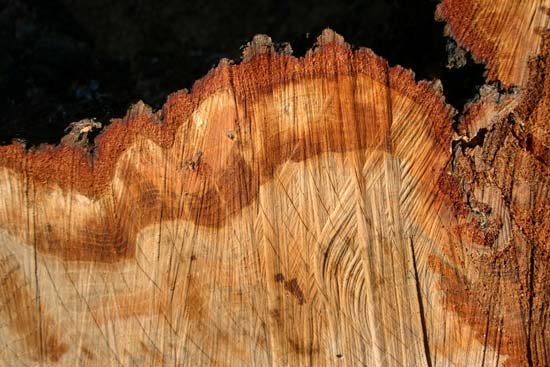Sandstone arch
Tuesday, 28 February 2006

Antidote to gloomy winter: revisit brilliant summer!—in this case, Pictured Rocks National Lakeshore on Lake Superior’s south shore in Michigan’s Eastern Upper Peninsula.
Tuesday, 28 February 2006

Antidote to gloomy winter: revisit brilliant summer!—in this case, Pictured Rocks National Lakeshore on Lake Superior’s south shore in Michigan’s Eastern Upper Peninsula.
Monday, 27 February 2006


Phone “tree.”
…a few vain lines in imitation of more learned men. (p. 58)
He lay with the book on his chest, now thinking that he’d always lived his life in hope of gain. When Joe Tenney, a better man, had lived in hope of gifts and giving. (p. 103)
—from Karen Fisher’s “A Sudden Country” (2005, Random House)
Ms. Fisher’s novel is a keeper. The setting is 1847 on the Oregon Trail. Her characters resonate and she reveals their hidden stories in slow, unanticipated pulses. She is very sensitive to the nuances of different cultures and walks of life, the very stuff of anthropology. Lest you imagine that this novel is “soft” and Victorian-kindly, here’re more of her words:
…by fifteen years of age, he’d learned what some of this world’s people could delight in.
He’d seen a Naskapi pull off a captive’s thumbs on long tendons, to string through his own ears for bobs. Seen a line of fires built inside a hall, gone in with the people who sat on benches as though waiting at a theater. Seen captives brought in to run through flames, to have their toes cleaved off with hatchets and be made to run again…he’d seen one night of torture so long and so inspired, so hateless and considerate in its artistry, as had left him sure the minds of such people would forever lie beyond the reach of men like him, who did at least ponder now and then the reasons for things. (p. 115)
All these quotes refer to the same character, MacLaren, whose mental moorings fluctuate. I do not remember encountering the name Naskapi before now. Googling reveals that the Naskapi are an Innu (native) group from eastern Canada (Quebec, Labrador) who eventually allied with the French against the Iroquois Confederacy. Is this a clue that MacLaren has traveled to eastern North America? [I haven’t finished the book yet….]
Trivia: what if the powder (not ricin, but substance hasn’t been named) the University of Texas student found on her roll of quarters (given to her by her mother) when she was preparing to do her laundry is…soap powder! (Thanks, John!)
Underlying theme of this entry: the obscuring of truths.
Pledge: I’ll strive to avoid overemployment of “vain lines” in this blahg.
Sunday, 26 February 2006
 There’s no other workable conclusion. It must be the end of the weekend: the leftover homemade pizza is gone. R U ready for Monday?
There’s no other workable conclusion. It must be the end of the weekend: the leftover homemade pizza is gone. R U ready for Monday?
Saturday, 25 February 2006
 John Kifner, in today’s NY Times (well, today on the web, tomorrow in print) notes that sometimes a there’s a turning point in history with two possible outcomes. After a dramatic event, things can continue to escalate, or they may reach a point of disruption such that affected parties are willing to agree to a stand-off. On Friday, religious leaders in Iraq sought to restore calm, but, as Kifner asks, will it last?
John Kifner, in today’s NY Times (well, today on the web, tomorrow in print) notes that sometimes a there’s a turning point in history with two possible outcomes. After a dramatic event, things can continue to escalate, or they may reach a point of disruption such that affected parties are willing to agree to a stand-off. On Friday, religious leaders in Iraq sought to restore calm, but, as Kifner asks, will it last?
Bear with me….
About 15 years ago, Richard D. Alexander* argued that the cognitive abilities that distinguish modern Homo sapiens from other creatures, including other hominins, developed to allow us increased social problem-solving, especially during periods of accelerated competition. The result was improved cooperation. Language is part of this evolutionary adaptive package that resulted in larger brains and the behavioral changes that distinguish us from other creatures.
Peter Turchin*, using cross-cultural analysis, notes that there’s a pattern to human population cycling, at least through history where we have the data, of this sequence: political instability leads to population decline (both lower birth rates and rising mortality rates from increases in crime and/or warfare), followed by emigration from hostile areas. All this is happening now in Iraq—and other beleaguered nations and regions.
Turchin’s patterns are at a different scale than those described by Alexander. Nevertheless, it seems that our development of weaponry has outdistanced our social cognitive abilities, and technology is triumphing over our intellects. Is a modern HAL 9000 next?
* References
Alexander, R.D. (1989). Evolution of the human psyche. In P. Mellars, & C. Stringer (Eds.), The human revolution: behavioural and biological perspectives on the origins of modern humans (pp. 455–513). Princeton: Princeton University Press.
——— (1990a). How did humans evolve? Reflections on the uniquely unique species. Museum of Zoology Special Publication No. 1. Ann Arbor: University of Michigan.
——— (1990b). Epigenetic rules and Darwinian algorithms: the adaptive study of learning and development. Ethology and Sociobiology 11:1–63.
Turchin, Peter (2003). Complex Population Dynamics: A Theoretical/Empirical Synthesis. Monographs in Population Biology No. 35.
——— (2003). Historical Dynamics: Why States Rise and Fall. Princeton, New Jersey: Princeton University Press.
——— and Thomas D. Hall (2003). Spatial Synchrony among and within World-Systems: Insights from Theoretical Ecology. Journal of World Systems Research 9:37–64. (Download here.)
Friday, 24 February 2006


Photo by Paul Hawthorne/Getty Images
I’m not comparing myself to Harry Connick, really! Love this photo from the Washington Post, where Harry shows off his flexibility during the curtain call on opening night for “The Pajama Game” at the American Airlines Theatre in New York City.
My jump, on the other hand, was for a budding journalist, for her class assignment back in my UGA days. She had to catch some action, as for a sports photo, to train her finger to stop the action instead of missing it.
Of course, John eventually took my photo into Photoshop and moved me an additional foot in the air! Talk about drama!
Thursday, 23 February 2006
 We found this while out in the spot of sunshine we had for an hour or so this afternoon, foraging for photos. It’s not a redbud, but what is it?
We found this while out in the spot of sunshine we had for an hour or so this afternoon, foraging for photos. It’s not a redbud, but what is it?
Some kind of ornamental shrub, probably from Asia?
Wednesday, 22 February 2006
 It’s been a rainy Atlanta winter day, and it’s getting rainier as the light fades. We’re reaching that part of the season when the pansies and camillias are beginning to fade. Replacing them, some of the flowering fruit trees—ornamental plums and cherries—are beginning to bloom, so the Bradford pears can’t be far behind!
It’s been a rainy Atlanta winter day, and it’s getting rainier as the light fades. We’re reaching that part of the season when the pansies and camillias are beginning to fade. Replacing them, some of the flowering fruit trees—ornamental plums and cherries—are beginning to bloom, so the Bradford pears can’t be far behind!
Me, I’m studying up on pivot tables, an exciting feature of Excel. The first self-help book I got from the county library, which alleged that it would help you solve all your Excel problems, had no mention of pivot tables. I took it back today (walking before the rain was just Seattle-mist) and got two other titles that had come in for me from interlibrary loan—including a “for Dummies” volume!—and these do have helpful material.
Tuesday, 21 February 2006

Where there is access to or acquisition of biodiversity (and/or related traditional knowledge) without prior informed consent, including prior informed consent about benefit sharing, on the part(s) of those whose biodiversity (or traditional knowledge) has been “accessed” or “acquired”, there is biopiracy—i.e., theft.*
—defined by the Edmonds Institute and biopirate hunter Jay McGown.
Intellectual property rights, which include biopiracy, is in part culturally situational, and there are no clear blanket answers to how to respect and codify them. In general, however, the poor, at whatever scale (from individual to nations of the third world) tend to be preyed upon by the non-poor, as in this example from Africa. But there are plenty of examples of the haves feeling like they’ve been stolen from: think of the many music tracks distributed via Napster, plus the torrents of current shows and movies, etc. How much is this nabbing of intellectual property “just” human nature? How much is it a consequence of our pervasive economic system, Capitalism?
Certainly, the current buzz about Google and Yahoo and the rest doing business in China vs. the attitudes of the Chinese government suggests the latter reigns. But, what if it’s also human nature to take (“beg, borrow, and steal”?)? How do we deal with this on the international scale then?
Either way, stay tuned to your favorite RSS streams or other information sources and you will encounter the latest news stories regarding intellectual property rights.
* From Out of Africa: Mysteries of Access and Benefit of Sharing (2006, Edmonds Institute and African Centre for Biosafety), page i. Download it here. The Edmonds Institute is a 501(c)(3) organization “committed to the health and sustainability of ecosystems and their inhabitants.” BTW, pages 8 and 9 discuss Hoodia, an appetite suppressant from a cactus that grows in the Namibian desert; development of Hoodia was based on traditional knowledge of the !San (used to be called Bushmen), and they receive only minor royalties from one company that sells Hoodia products. In most cases cited in this document, local peoples receive no compensation whatsoever. However, in many examples the organism used for the patent (or pharmaceutical or enzyme or …) is not explicitly linked to indigenous knowledge, so it’s difficult to evaluate the intellectual property rights involved.
Monday, 20 February 2006

Tamales and atole for breakfast.
Nixtamalization is a process discovered by the Aztec and Maya civilizations of Mesoamerica….*
False.
So superior is nixtamalized maize to the unprocessed kind that it is tempting to see the rise of Mesoamerican civilization as a consequence of this invention, without which the peoples of Mexico and their southern neighbours would have remained forever on the village level.*
Please!
Archaeological data suggests the lime-treated ground maize dough was being made and eaten when the largest Mesoamerican settlements were villages.
Overall, however, I do find useful information in this volume, and am glad to have it. Still, foodies must be careful that their received knowledge has a basis in science—and the rest of the real world!
* From entry “Nixtamalization” in Alan Davidson’s The Oxford Companion to Food (1999, Oxford University Press), page 534.
Sunday, 19 February 2006
 Today’s one of those overcast, sharp-breezy winter days that make me crave summer sunsets—pink, warm, placid and pacific. Out of the frame is a perfect s’mores fire and a crowd of soft-talking, laughing friends.
Today’s one of those overcast, sharp-breezy winter days that make me crave summer sunsets—pink, warm, placid and pacific. Out of the frame is a perfect s’mores fire and a crowd of soft-talking, laughing friends.